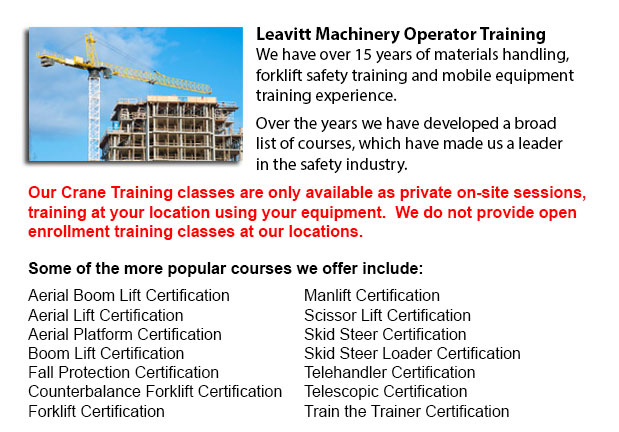
Overhead Crane Safety Training Edmonton - The overhead crane safety training course is designed to equip the operators with the right skills and knowledge in the areas of: crane safety precautions, materials handling, accident avoidance, and equipment and stock protection. Each of the trainees will get to learn on many kinds of overhead cranes, their capabilities and their uses in various settings. For operators who are trained and licensed, the shift in liability moves to the operator from the company. Thus, the program emphasizes individual operator tasks.
The operators in the overhead safety training program would be given instruction about the correct ways for doing inspections: the pre-shift inspection and the more detailed in-depth inspection. These are important daily routines which must be logged. Correctly recorded pre-shift inspections help to protect the company from liability in case of an accident. Pre-shift inspections likewise prevent accidents, damage and expensive repairs. Operators learn how to designate a specific individual to handle inspections, how to report problems, and how to maintain the log book.
Each and every inspection must be carried out and documented regularly. Things which should be checked for possible concerns, include: hooks for cracks, increases in the throat opening, hoist ropes for corrosion, degree of twist, worn wires, loss of diameter, bird caging and kinks, broken wires, chemical and heat damage; chains for gouges and nicks, twists, cracks and corrosion, distortion, excessive wear, stretching, pits, damage from extreme heat.
The operator would get to learn the right techniques about proper rigging procedures. The process of rigging involves the understanding of the manufacturer's data plate, determining the weight of materials to be lifted, selecting the gear, and utilizing safe practices to secure the load. The program cover in detail the following: safe working loads, and the capacities of ropes, chains, slings, hooks and shackles.
It is vital to know who can utilize the cranes at your facility, physical requirements of the job, and operator credentials required for permits and specialized tasks. Safety is a top priority when using near pedestrian traffic.
Safe crane utilization involves duties like for example checking for hydraulic leaks, undertaking visual inspections, testing the controls, checking the safety guards, examining the hook and hoist rope, limit switches and braking mechanisms. Correct reporting procedures are critical. These subject matters are all included in depth in the course.
The course also consists of the proper moving and lifting procedures with hoists and cranes. Operators would also learn proper hand signals. Training includes how to raise the load, attach the load, unhook the slings, abort a lift and set the load.
Moving the load includes several steps: stopping and starting procedures, controlling and guiding the load, working with signals and observing working conditions. Operators have to know how to proceed in the event of a power failure. The program includes techniques for lowering the load and removing the slings, storage of equipment, parking the crane, and securing an indoor and outdoor crane.
-
Forklift Training Programs Edmonton
Forklift Training Programs Edmonton - If you are searching for work as an operator of a forklift, our regulatory-compliant lift truck training programs provide excellent instruction in numerous styles and types of forklifts, classes on pre-shift insp... More -
Heavy Equipment Training School Edmonton
Heavy Equipment Training School Edmonton - The heavy equipment operator courses will assist the operator in acquiring the required skills and knowledge they will require to be able to enter the workforce as an entry level operator. In this 12 week co... More -
Manlift Ticket Edmonton
Manlift Ticket Edmonton - The Elevated Platforms and Manlifts Certification program helps to provide the necessary training on the safe operating procedures, work practice, rules and regulations regarding the daily activities for the operators of thi... More -
Crane License Edmonton
Crane License Edmonton - Crane operators must be "credentialed", which means they must have a crane operator license or certification. Credentialing is considered a mandatory governmental requirement in order to practice as a crane operator. Having a... More -
Counterbalance Forklift License Edmonton
Counterbalance Forklift License Edmonton - When operated by totally trained operators, forklifts could become a major advantage for firms and companies. We could offer your staff a comprehensive training program which covers all aspects of operating... More -
Manlift Safety Training Edmonton
Manlift Safety Training Edmonton - Manlift operators have to be aware and cognizant of all the potential hazards which are associated with particular types of scissor lifts. They need to be able to operate the scissor lift in a way that protects not... More -
Forklift Training School Edmonton
Forklift Training School Edmonton - Forklift Training School And Reasons Why It Is Really Important - Industry and federal regulators have established the criteria for forklift safety training based on their existing standards and regulations. Indivi... More -
Crane Certification Edmonton
Crane Certification Edmonton - The Crane Certification training program covers subject matter suggested by industry regarding the efficient and safe operation of cranes. People training will be taught the following: how to identify cranes and their c... More

Forklift Training Edmonton
crossorigin="anonymous">
TOLL FREE: 1-888-254-6157
Edmonton, Alberta
forklifttrainingedmonton.com
Email Us
About Us


